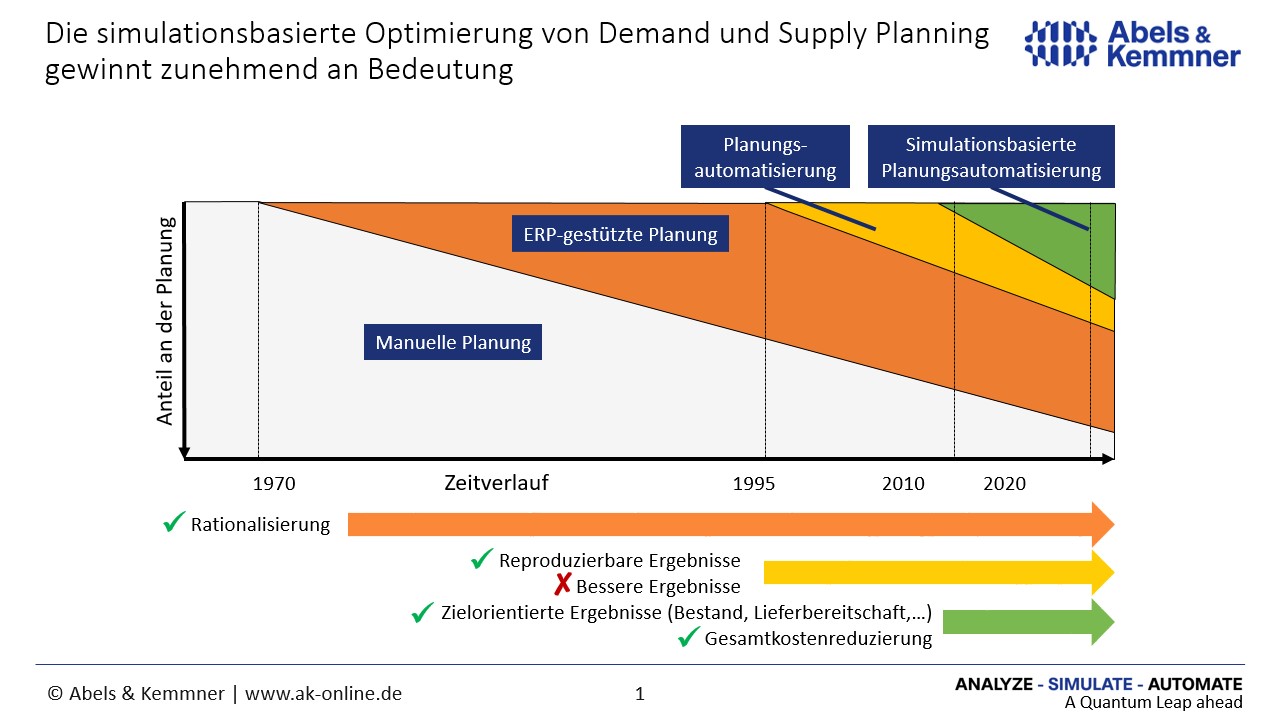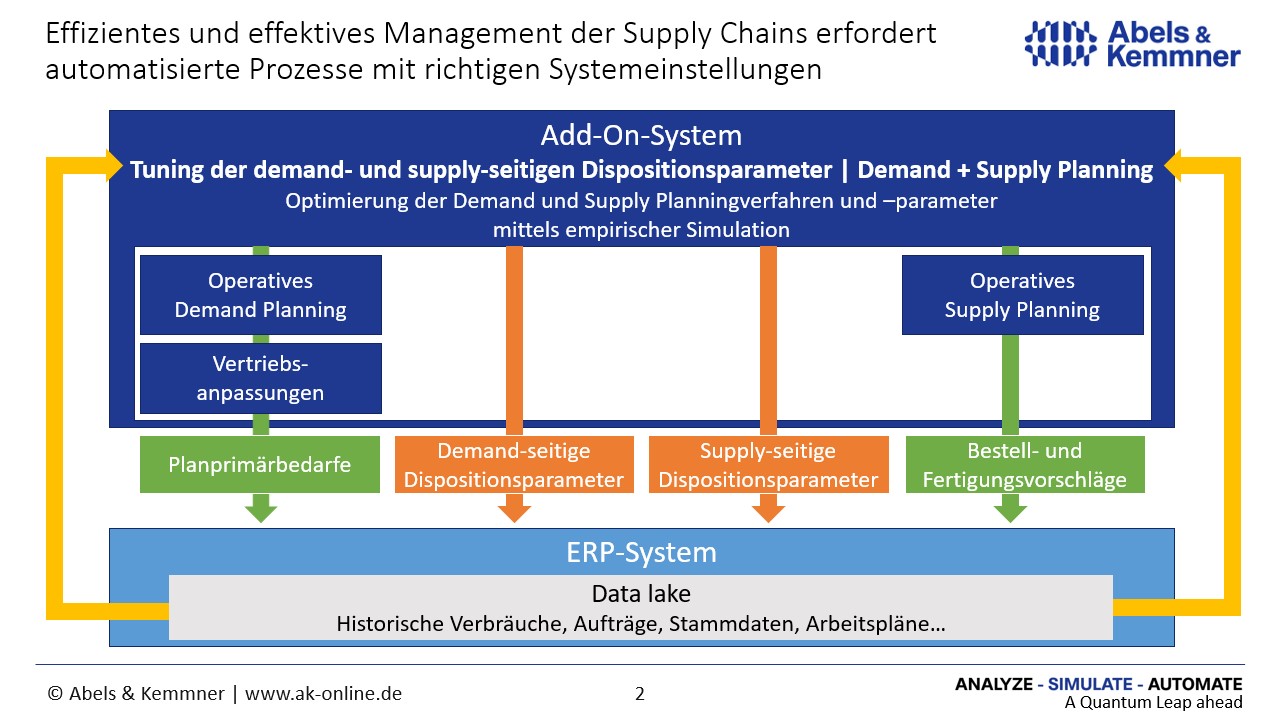Efficient supply chain management today is demonstrated by a planning chain that is as automated as possible, from sales forecasting (demand planning) to scheduling (supply planning).
Ein leistungsfähiges Supply Chain Management muss effektiv und effizient sein.
The effectiveness of supply chain management can be recognized by a high readiness to deliver with the lowest possible inventories. Inventories are an organizational lubricant and little lubricant indicates a smooth value chain.
Many companies are still a long way from managing their supply chains efficiently. Experience from the crises of recent years has shown that companies with a functioning sales forecast have reacted faster and more consistently both to the onset of the recession and to the recovery of the market.
Despite everything, many decision-makers underestimate the importance of sales forecasting for a company’s success: on the one hand, you come across companies that believe they are sufficiently positioned with their own expertise and existing ERP system. They don’t even realize how bad they are because they don’t let anyone show them how good they could be.
On the other hand, some companies believe that in the age of lean management and market-synchronized production, sales forecasting is no longer necessary and that poor delivery readiness or high inventories are the fault of their dispatchers. But what should you do in supply planning if demand planning sets the wrong course?
Ohne leistungsfähiges Demand Planning geht es nicht
All planning in the company and all logistical goals – from reducing stock levels to ensuring delivery readiness, from adherence to delivery dates to optimum capacity utilization – are based on a reliable sales and demand forecast. However, the sales department is rarely in a position to provide reliable sales forecasts. This makes it important to develop sales and demand forecasts based on customer order or consumption histories for your own products and to have the sales department only readjust to market trends.
Keine simulative Optimierung und meist auch keine KI-Verfahren
The field of demand forecasting has come a long way in terms of technology in recent years. In relation to what is possible and necessary, the forecasting capabilities of practically all ERP systems are very limited and usually do not meet the realities of practice: Most ERP systems concentrate on statistical methods that assume normally distributed demand, have no distribution-free methods, try to optimize forecasting solely on the basis of the forecast error instead of the MRP error, have no simulative optimization and usually no AI methods; the list could go on. Disturbance variables, such as corona-related demand effects, are also difficult to eliminate.

Depending on the demand structure, it may be sufficient to make the best possible use of the limited forecasting options in the ERP system. In this case, however, an empirical simulation must at least be used to determine which settings (“demand-side scheduling parameters”) must be made in the system and how effective the forecasts will be. We use the DISKOVER SCO (Supply Chain Optimizer) add-on system to tune the corresponding ERP settings.
DISKOVER’s algorithms are self-learning and select the best possible forecasting and safety stock procedures and parameters according to alternative specified optimization targets such as delivery readiness, costs or inventory. Tuning the forecast settings of the ERP system is not a one-off process, but must be carried out regularly to ensure that the settings are updated in the best possible way. So you regularly need a suitable add-on system as a tuning tool.
As powerful tools play in a different league than ERP systems in terms of forecasting, it usually makes sense in demand planning to transfer the forecast results directly from the add-on system to the ERP system as planned independent requirements instead of just parameterizing the limited options of the ERP system. Modern add-on tools are so sophisticated that the forecasts are created fully automatically without the user having to intervene in the process and therefore understand the mathematical relationships.
In this way, demand planning becomes effective and efficient and, according to our many years of experience, this is the only way to achieve the goal of high delivery readiness with the lowest possible inventory.
Nur mit einem leistungsfähigen Supply Planning steht das Supply Chain Management auf festen Fundamenten
Determining the best possible forecasts and safety stocks is a necessary but not yet sufficient step towards an efficient supply chain. Effective and efficient supply planning is also required. To do this, the correct algorithms and settings for determining order dates and order quantities must be found and adjusted for each item. A typical weakness of supply planning in many companies is the inadequate maintenance of supply-side planning parameters. These must be regularly readjusted and must not be touched just once when the article is created in the ERP system.

However, regular maintenance of the scheduling parameters by the schedulers and production controllers themselves is unrealistic for time and technical reasons. The workload required for this alone quickly amounts to a third to half a full-time position per dispatcher. In addition, the interplay of requirements, forecasts, scheduling decisions and value streams in the company and throughout the entire supply chain is so complex that it can no longer be penetrated with common sense alone; even proven scheduling experts and consultants fail here without suitable technical aids. As with demand planning, the economically correct scheduling settings can only be identified in a reliable and resilient manner using simulation, especially as numerous company-specific influencing variables and interdependencies must be taken into account.
Was ist der Unterschied zum Supply Planning?
In contrast to demand planning, the supply planning functionality of some ERP systems is very sophisticated. There are therefore two optimization alternatives for the more powerful ERP systems in supply planning. One alternative is to carry out the entire scheduling process in the add-on system and return the results to the ERP system in the form of order and production proposals.
With the second alternative, only the supply-side scheduling parameters are optimized in the add-on system and readjusted daily in the ERP system. The prerequisite in both cases is that the add-on system continuously and automatically adapts its own or the ERP-side parameter settings to the changing boundary conditions of the items to be planned in order to relieve the users in terms of time and expertise and thus make them more productive. This is where many of the classic scheduling add-on systems fail.
Fazit: Neben hohen Einsparpotentialen auch Aufwertung von Arbeitsplätzen
However, this is the only way to reliably achieve the desired goals, such as reducing inventories, improving delivery readiness or reducing overall costs, the only way to make scheduling and production control more “process-stable” and work more efficiently, and the only way to achieve 80% automatic replenishment. The time saved can then be used to regulate special cases so that delivery readiness levels of 98% and above no longer pose a challenge.
You can find best practice tips on this topic here White Papers

